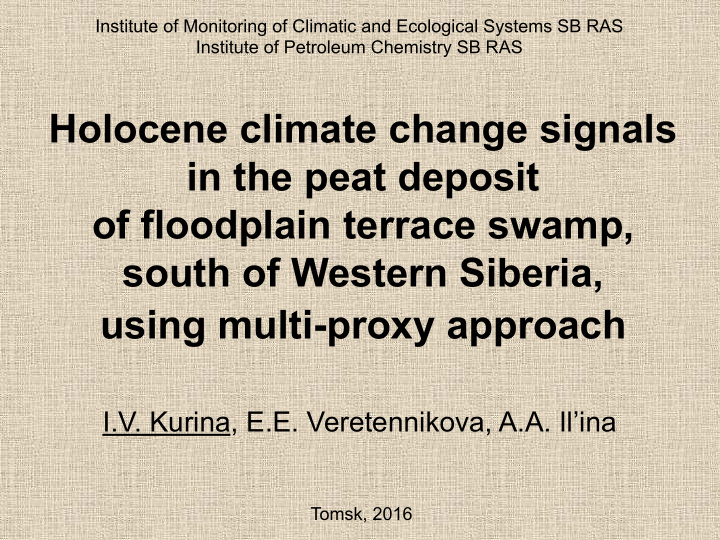



Institute of Monitoring of Climatic and Ecological Systems SB RAS Institute of Petroleum Chemistry SB RAS Holocene climate change signals in the peat deposit of floodplain terrace swamp, south of Western Siberia, using multi-proxy approach I.V. Kurina, E.E. Veretennikova, A.A. Il’ina Tomsk, 2016
Mires is a source of paleoecological information Image is taken from the Internet site gis-lab.info
Aim of our research: • to reveal the Holocene climate change signals in the peat deposit of floodplain terrace swamp.
Study area Southern taiga of Western Siberia (56°55' N, 82°30' E) Bakchar river swamp “Samara" Image is taken from the program Google Earth
Methods • 14C dating • Macrofossil analysis • Ash content, % • Rhizopod analysis • Humification index • Water table depth reconstruction • Spectral characteristics of humic acids
Object of the research – swamp “Samara ” C14 dates grass and sedge peats 3050 + 40 brown moss – sedge peat Depth, cm brown moss 3870 + 40 peat brown moss – sedge peat 4250 + 40 4740 + 40 grass peat 7620 + 130
Testate amoebae and water table depth reconstruction (WTD)
Hydrological conditions of the swamp development Water table depth, cm Humification index Ash content, % Age, cal yr BP
Spectral characteristics of humic acids (HA) HA, mg/kg of peat Age, cal yr BP
Results. 1 stage of the swamp development (8500-4600 cal yr BP) WTD, cm Ih Ash, % HA, mg/kg Age, cal yr BP
Results. 2 stage of the swamp development (4600-3500 cal yr BP) WTD, cm Ih Ash, % HA, mg/kg Age, cal yr BP
Results. 3 stage of the swamp development (3500-0 cal yr BP) WTD, cm Ih Ash, % HA, mg/kg Age, cal yr BP
Conclusions: • Climatic variations have been recorded in the swamp deposit • Climate has a strong influence on swamp development
Thank for your attention! Questions ???
Recommend
More recommend